Feet of Clay
“Ralph and I simply stood in awe. It was as though someone had just opened his lunchbox and exposed the Hope Diamond. The word ‘priceless’ was invented for objects such as this ancient masterpiece.”—William A. Balk, Jr.
Epicurus’ Porch
By William A. Balk, Jr.

ELKO South Carolina—(Weekly Hubris)—March 2017—To discover that your adored long-time hero has turned out not to be the paragon you always thought her to be is one thing. It’s quite another to find out, accidentally, that your most cherished piece of pottery has feet of clay.
But I’m getting ahead of the story.
Try to name the greatest work of art in a cosmopolitan city such as Washington, DC. The city is full of museums built around breathtaking collections of art, and there are more than a few private collections which contain treasures as fine as those in the museums. It’s unlikely that you would name as your choice a small, chipped, irregular, blackened bowl with a bit of dried tea in the bottom.
The tea bowl, or chawan, would not quite match the Titian at the National Gallery or the Henry Moore at the Hirshorn in their commanding presence or their tour-de-force display of technical mastery. The poor little tea bowl was uneven and rather thick-walled; it wasn’t even turned on a potter’s wheel. Instead, it was formed by hand, fingertips molding bits and coils of clay to make a not-very-straight-sided bowl to hold in your hand. The maker added a round foot to raise the bowl a bit off a table when you put it down.
Okay. Maybe it wasn’t the greatest work of art in Washington. But it was probably the most humble. And that was the measure of its importance.
A great painting or sculpture may cause us to pause and reflect, to meditate on the purpose or meaning or beauty, to make connections both imaginative and emotional. This clunky chawan was created to do the same.
The guy who made the tea bowl, Tanaka Chojiro, was a country potter, making lots of tiles for roofs, everyday housewares, and the occasional bowl for drinking tea. He had neither a potter’s wheel—certainly not needed for making flat tiles—nor a particularly hot kiln, like the ones required to produce the majestic, elegant, decorated porcelain ware so prized all over Japan and beyond.
In 16th-Century samurai Japan, social status had become highly competitive, and social encounters like the revered tea ceremony, which was ritualized to accord with Buddhist practice and meditation, had become vehicles for the ostentatious display of wealth or power. A few Buddhist leaders began to criticize such displays. The tea ceremony, which was of central importance in the social and religious life of the community, had become corrupt and impure. A few Buddhist leaders began to rethink the ceremony as a way to return to a purer, simpler way of living in the world.
The most powerful warlord of late 16th-Century Japan, Toyotomi Hideyoshi, had chosen as his household’s master of the tea ceremony—a position of great significance and influence—sen no Rikyu. Rikyu quickly grew quite close to Hideyoshi and rose to become the most influential master of tea in the country, receiving recognition and acknowledgement from the emperor.
Rikyu began to develop a simpler, more spartan ritual for the tea ceremony, making simple implements from bamboo and plain wood to focus on the essence of the moment, the purity of one’s heart. He found the uneven simplicity, the unpretentious directness, of the little bowls made by the local tile-maker Chojiro perfect for this new type of ceremony, so he commissioned some bowls from the potter for his use.
Rikyu’s master, the warlord Hideyoshi, was pleased with the new tea ceremony and, quickly, this rustic style became the fashion throughout much of Japan. Rikyu himself grew in influence and importance in defining the tea ritual, and Chojiro, the potter, was celebrated and commended.
Chojiro was given the title Raku, granted by Hideyoshi in honor of his work. He was the first of his family to hold the name. Later, unfortunately, the court’s tea master, Rikyu, would be ordered by Hideyoshi to commit seppuku (ritual suicide) for a perceived slight to his master.
The successors of Chojiro, Raku I, usually sons in the line, but sometimes reaching outside the hereditary lineage, have continued the tradition of making among the most honored and celebrated ceramics in Japan. Raku Kichizaemon XV is the current master to work in the lineage, making tea bowls and other pieces sought by major museums around the world.
![]()
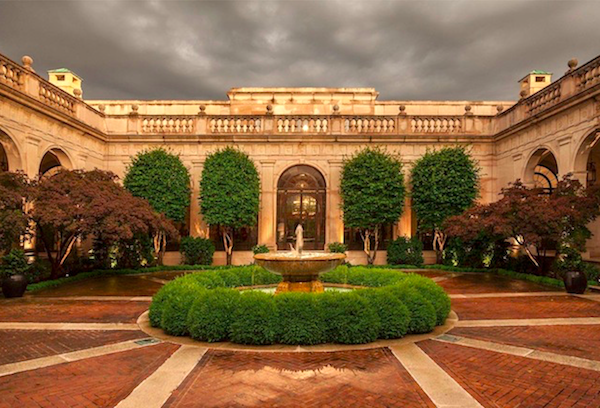
The American Gilded Age, toward the end of the 19th Century, saw many of the newly super-rich seek to acquire status by acquiring art. The Morgans, Vanderbilts, and Rockefellers followed the style of the day in buying up vast quantities of European art, usually Old Masters and heavy European Renaissance objects, paintings, and even architectural elements.
The railroad magnate, Charles Lang Freer, instead began collecting the much less appreciated American artists, among them, James McNeill Whistler. Freer’s collection of Whistler is probably the best in the world, and his friendship with Whistler introduced Freer to the Aesthetic Movement in art, which in turn drew Freer inexorably toward Asian art. The collector had found a new area to explore, and he began to acquire superb examples of Asian porcelains, carved jade, stone and bronze sculpture.
In 1902, Freer made a purchase from the leading dealer in Japanese art, Bunkio Matsuki, acquiring for his burgeoning collection a small black raku chawan of the 16th– Century workshop of Chojiro—Raku I. The bowl was accompanied by substantial records of provenance, and all were kept in their original 16th-Century wooden presentation box, marked with the bowl’s name and history along with a poem in calligraphic script. Matsuki’s imprimatur, as the preeminent expert and importer for Asian art, commanded premium prices for such excellent art. The little tea bowl was a very special piece, despite its humble appearance.
Freer ultimately offered to President Theodore Roosevelt the gift of his entire collection, some 8,000 pieces, with funds to construct an appropriate building on the National Mall in which to house it, as well as funds to maintain the collection.
In 1906, the Smithsonian Board of Regents accepted the gift for the nation. When the Freer Gallery of Art finally opened in 1923, adjacent to the old Smithsonian “Castle,” Freer had already died and never saw the finished building, which held not only his Asian collections and galleries of American art, but also the Whistler collection. The museum rebuilt one of Whistler’s most famous creations, the grand Peacock Room, and constructed enormous storage facilities for objects not on display.
![]()
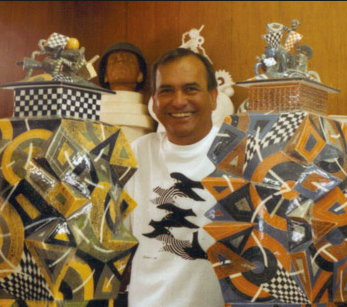
Ralph Bacerra had already achieved substantial critical success as a ceramic artist when I first met him in the late 1970s. He had added to his reputation wide recognition as a great teacher of ceramics. He had taught at the Chouinard school in California and later at the Otis institute. His students over the years include some of the superstars of studio ceramics, including Elsa Rady, Adrian Saxe, Peter Shire, and Mineo Mizuno.
Ralph had learned from the iconic Viveka Heino. It was Heino from whom I bought my first pot, a lovely, tiny, porcelain bowl with a perfect pale celadon glaze and with striking temmoku (a brown-black, iron-based glaze) spots brushed on. I remember very clearly writing out my check for $8.00 for the piece. It’s now almost a half century later, and I still have that exquisite little bowl, even though other pieces from my collection have gone to the Brooklyn Museum and the Los Angeles County Museum of Art. And I still keep a couple of my Bacerras.
In the late 70s, Ralph was making a trip to Washington for a major show of his work at a gallery two of my friends owned in Georgetown. I was invited to meet the artist, whose work I had already admired but could not afford, at a small dinner at my friends’ house on Capitol Hill. We talked for hours, and I learned far more about ceramics—and the artist—than I could imagine learning from a conversation
The next morning, I got a call from Ralph inviting me to join him to see a particular Japanese pot he had heard was in the Freer collection. It was not on display but, rather, was housed in the bowels of the museum to protect it from handling and from light. Martin Amt, then the Special Assistant to the Director of the Freer Gallery, had arranged to meet us and show us the pot.
Overwhelmed with excitement, I rushed to meet Ralph and Marty at the grand bronze doors to the Freer before the public were let in; we were led on a quick private tour of several magnificent collections on display; we were told to be sure to see the Whistler Peacock Room before we left; and then we were led to a concealed elevator, which took us down to the halls, offices, and storage rooms below the museum.
These subterranean spaces were certainly less grand than the great marble rooms above, and I guessed we would be taken to functional steel shelving unit in some dusty corridor to view the pot Ralph had wanted to see.
Instead, we were shown into an orderly office with a number of closed and locked cabinets along two walls, filing cabinets, a couple of chairs, and a plain office desk, overflowing with papers, in the center of the room. This was Marty’s own office. He walked us over to one of the low cabinets along one wall, took out a key, and unlocked the cabinet door.
Casually—but carefully—Marty reached into the cabinet and withdrew a small, black tea bowl, lovingly shaped by a master’s hands, made to fit perfectly in the hands of a tea drinker, the rim of the bowl uneven but smooth, for pleasing the drinker once his lips touched the edge, sipping the pale green liquid it held. There was a tiny chip near the rim, a relic of the bowl’s centuries of use, an enhancement of its meaning and, therefore, its value.
“Chojiro,” Marty said. “Raku I. From about 1575.”
Ralph and I simply stood in awe. It was as though someone had just opened his lunchbox and exposed the Hope Diamond. We both knew that even a brand new chawan made by a modern master potter—not of the Raku family—might fetch anywhere from $10,000 to $20,000. The word “priceless” was invented for objects such as this ancient masterpiece and, as such, they may be designated National Treasures of Japan. This one, now resident outside Japan, could not be named a national treasure, of course; but there was no doubt it was one, wherever it came to rest.
Ralph and I were silent, and I was still trying to catch my breath, when Marty simply reached over to hand the bowl to Ralph, who took it. Ralph was a potter. Naturally, in holding the pot, he could absorb much more than I could of the hands that made it, of the raw materials used to make it, of the texture of the smooth black glaze.
Ralph was also a student of present day masters of clay; he had himself studied extensively in the potteries and museums of Japan, and he had on several occasions held rare and precious tea bowls made by the Raku family. This one, the one in his hands, was investigated by Ralph’s fingers perhaps more than by his eyes and mind.
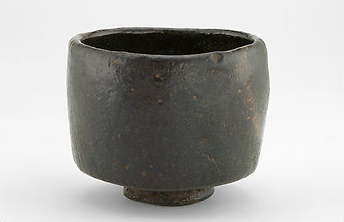
After several thoughtful moments, Ralph returned the bowl to Marty Amt, who then turned to me as though to ask me to take it next. I was dumbfounded; reluctantly, I extended both hands and took the bowl.
It was surprisingly light. The surface, although glazed, felt a little roughened by its four centuries of wear. I looked inside it and recognized the residue in the bottom from a tea ceremony perhaps hundreds of years ago. The round foot of the bowl fell precisely where my hands almost met beneath the bowl, where it formed a kind of steadying ridge that kept the bowl still and settled. When holding the bowl, one’s posture became remarkably, and naturally, the posture of prayer. After only a few moments, I nervously handed the bowl back to Marty.
None of us had spoken but, once the bowl was returned to its shelf in the cabinet, we all began to speak at once. Ralph, who had remained calm while handling this precious object with such ease, remarked that the bowl had felt different from what he had expected. He had only held one other bowl from Chojiro, but he had studied several others in museums in Japan; Ralph said there was something just a little different about this one, something he needed to think about. I thanked Marty Amt profusely for his generosity and kind accommodation of our visit, Ralph expressed his own gratitude, and we left to tour the museum’s brilliant and varied collections on display.
As we wandered among the treasures of the Freer collection, once the awe had diminished a little after our encounter with Chojiro, I asked Ralph what his reaction to the little tea bowl had been.
“Well,” he replied, “it seemed to me that the bowl was just a tiny bit different in thickness, the glaze not precisely what I remember of Chojiro’s tea bowls. Every one of them, of course, is utterly unlike any other, so it’s really hard to put my finger on it.”
“Are you doubtful?” I asked. “About the attribution to Chojiro, I mean?”
“It’s a superb, exquisitely fine pot. No question. I don’t doubt the scholars, but there’s no quality in the object itself which definitively says it was made by the hand of Chojiro. The Chojiro pots I studied in Japan all could have been made only by Chojiro. As varied as they were, they all shared a unique quality which I now understand is the hand of Chojiro, himself.”
I was coming down from my high quickly. “You think it’s not Raku I? Will you tell the museum?”
Ralph laughed. “No,” he said. “I’ll write a note of thanks to Marty. I’ll mention what my reactions are. But I mean them only as observations, not criticisms. I have no basis for not attributing the bowl to Chojiro, and the Japanese historians have maintained its authenticity. It is an exquisite bowl for the tea ceremony; it was created in humility and intended to serve humbly in the contemplation of man’s small place in the universe. Maybe we should let it do that, and not elevate it.”
I was thoroughly confused at that point. We had reached the Freer Gallery’s installation of Whistler’s Peacock Room. Entering that astonishing space, surrounded by rich teal-blue leather walls, intricate wood carving and gilt-painted peacocks, we could only marvel at the magnificent space Whistler had made. Chojiro’s little bowl seemed less overwhelming once we were within this Whistler room.
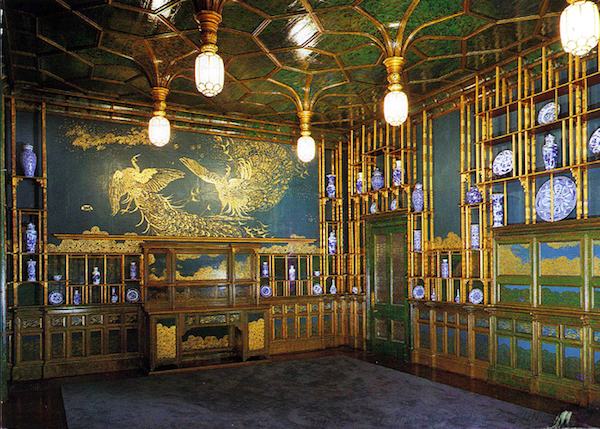
The bowl, however, and the experience of anticipating it, seeing it, and then actually holding an object of such import—a day spent in the company of an artist I idolized, spent seeking out an object of inestimable value, and being able to handle it—all that crystallized in my mind as a memory of great significance, one to hold and cherish, and to revisit in my memory castle. The fragility of the object—the fragility of its attribution! —became a magical touchstone for me. It is vivid still.
I did do some research as the years passed, wondering about the rightness of the bowl’s being credited to Chojiro. It has never been on display in the Gallery. Recently, after the Freer (now called the Freer/Sackler, for its conjoined structure housing two collections) has gone through renovations and redesigns, massive cataloging of collections, and reassessments of the objects in the collections; recently, I have discovered that Ralph’s doubts about the little tea bowl are now shared by other scholars. Chojiro’s claim to the piece has not actually been revoked, but the collection notes that “. . . current understanding . . . provides new interpretations . . .” of some of the anomalous features Ralph once noticed.
No reinterpretation, however, is needed of the experience it gave me. That day at the museum provided impetus for study and for a more serious approach to collecting. I built a wonderful collection which engaged my mind and my senses, taught me, and provided me with rewards both measurable and incalculable. I realized that the search (for knowledge, for treasure, for the Holy Grail) can be richer and more fulfilling when one is accompanied by another seeker—especially one who is a teacher, as well. And I hold firmly to the lesson that one’s reward at the end of the search may not be what one set out to attain.
My life has been full of such quests, such guides, such recompense. This one, this search for Chojiro, enriches all the subsequent expeditions I’ve undertaken, and I expect it to continue to do so throughout all my remaining years.
![]()
Photo Credits:
1. Tea Ceremony, 1895 is in the public domain and was found in Wikimedia Commons.
2. The Freer-Sackler Galleries, courtesy of the Freer-Sackler Galleries of the Smithsonian Museums.
3. The image of Ralph Bacerra, courtesy of the Ben Maltz Gallery of Otis College of Art and Design.
4. Raku Tea Bowl, courtesy of the Freer-Sackler Galleries.
5. The Peacock Room, courtesy of the Freer-Sackler Galleries.
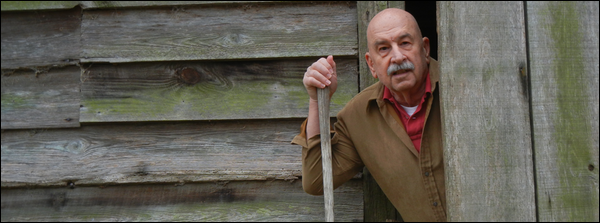
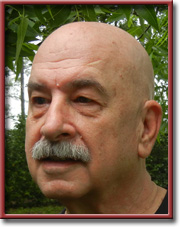
4 Comments
Alex Billinis
“No reinterpretation, however, is need of the experience it gave me.” Thank you for sharing such a sublime moment. I have had some of these, but it is hard to impart them with the delicate and thoughtful detail that you have, Will.
Will
….always hoping for the sublime…….it IS wonderful, isn’t it Alex, to find those rare moments? Like our dear EBH’s reflection on that
diana
Will, dear, you have unveiled yet another, surprising side of you. Thanks for the glimpses. Re porcelain, I had a summer job in the early 60s at The Antique Porcelain Company on 57th st in NYC. My job was sitting at the entrance, welcoming the very few people who dared enter, and dusting. One day I chipped a priceless Sevres sugar bowl and was mortified. Hans Weinberg, an amazing former judge who had escaped Berlin just in time and passed secrets by speaking Latin, told me not to worry. His wonderful repairman, Jesse, would put it back together and the price would go up! I see from your column that he was not the only one to know the value of wear and tear.
Will
Diana, I am always being surprised at how much we have in common, despite our divergent lives! What a fabulous summer job, surrounded by all that glory! You know, I’m beginning to feel that cherishing the history (aka: respecting wear, tear, and especially repair and continued use) of objects becomes less and less a part of our consciousness – except of course for “recycling,” which itself seems to be difficult to imbed within our psyche. I would have been awestruck to meet a craftsman such as your repairman friend, Jesse!